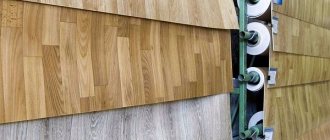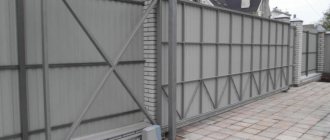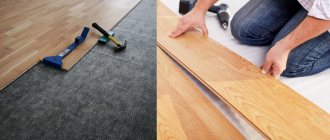Today, soft roofs not only occupy a leading position in the market, but have become a real discovery for designers and architects. Many styles, individual solutions and the possibility of easy implementation on complex roof structures - what more could you ask for? The main thing is to achieve absolute tightness between the shingles, on which the durability of the entire coating depends. And the installation of flexible tiles itself will be within your power, believe me, even if this is your first time encountering this type of work!
Therefore, if you carefully read our tips, you will be able to cover even a large roof with the help of one more person. The fact is that even in the factory, shingles are prepared for gluing by applying a special solution to the bottom layer, and they even make four holes so that you know exactly where to drive in the roofing nails. And now we will tell you about all the intricacies of working with soft roofing.
Step 1. Installation of the roofing pie
If the attic is cold, then all the moisture will come out of it on its own, using natural ventilation. But in the case of a residential attic, a vapor barrier is necessary. It is laid on the inside, protecting the insulation from moisture. The vapor barrier film is installed with an overlap and taped with special tape (regular tape is not suitable).
Next, lay the selected insulation on the outside of the vapor barrier film, preferably staggered. Cover the top with a windproof membrane and secure with bars, which will also later serve to create ventilation channels.
As a result, you should end up with a “layer cake” like this, as roofers like to call it:
We have prepared for you a detailed master class on how and in what order everything should happen:
Installation of the base under soft tiles
One of the most important points is arranging the base for soft tiles. It is advisable to entrust this work to professionals, since it requires special knowledge and skills.
The mandatory list includes:
- arrangement of the rafter system. In this case, you need to correctly calculate the weight of the roofing pie together with the finishing coating and probable precipitation;
- vapor barrier. A mandatory layer that will prevent the accumulation of condensation and wetting of the wood;
- waterproofing. Protects from cold.
- insulation. To select a specific option and thickness of insulation, you need to make an accurate calculation;
- directly base. OSB boards or plywood sheets are laid to level the surface.
OSB is an oriented strand board, which is a wood layer consisting of several sheets of natural particle material glued together with special resins containing artificial waxes.
Step 2. Installation of continuous flooring
To install flexible tiles, a rigid solid base is required. Therefore, mount a solid carpet of plywood or OSB boards on the prepared sheathing, with a gap of 3-5 mm, which is necessary for thermal expansion, and secure it to the rafters with self-tapping screws.
The main requirement for a base for flexible tiles is a flat area and the ability to fix the shingles with nails. For this purpose, sheets of glued wood shavings similar to plywood or tongue-and-groove boards laid end to end are suitable. Only the board should be as dry as possible so that waves do not form during drying. But it’s a big mistake to use only the sheathing itself, albeit more frequently, for a soft roof, because already in the first season the entire roof will simply go in waves. And photos with such problems become a real asset for manufacturers who scare their customers with such errors.
Once the base is ready, reinforce the eaves overhang with metal strips. These are laid edgewise on the edge of the base and secured with roofing nails, in increments of 150 mm, in a checkerboard pattern:
Rules for preparing for installation
To lay flexible tiles, prepare the following tools:
- construction hair dryer;
- scissors designed for cutting metal;
- small spatula;
- screwdriver;
- hammer.
Construction hairdryer
As for the materials, you will need the flexible tiles themselves, self-tapping screws, a special lining (you can use roofing felt), roofing nails (diameter 8-12 mm, length from 25 to 40 mm; approximate consumption of nails - 10 kg per 100 m sq. area), mastic for sealing joints, hydro-, steam- and heat-insulating material, as well as adhesive tape (double-sided is required).
Fragment of a roofing pie
Step 3. Selecting and installing the substrate
Now is the time to take care of waterproofing. It is necessary in such difficult places as abutments, joints and valleys. Here the canvases are laid from bottom to top with an overlap of 10 cm in the longitudinal and 15 cm in the transverse direction:
We recommend that you use a specially designed underlay rather than roofing felt or similar material, as is sometimes done. The fact is that they and the finishing roofing coating have different service life, and even conditions of use!
And such an attempt to save money will soon lead to swelling of the entire roofing carpet. In addition, no manufacturer will provide a guarantee for a roof that contains materials from third-party manufacturers.
By the way, until recently, lining carpets were practically not used in Russia, and even today many people try to cheat. This is logical, because by the time the roof is built, it often turns out that the planned budget for the entire house is not enough, and concessions have to be made. But, if you want to lay roofing tiles and forget about it for many decades, then do not give up such an important element.
There is always a risk that water will penetrate into the under-roof space, especially in such difficult places as bypassing chimneys or contact with an installed antenna. There are also emergency situations when strong winds lift shingles during a rainstorm.
Moreover, choosing a roofing carpet is not difficult, because... it is subject to the same requirements as tiles: to be resistant to temperature changes, provide reliable waterproofing and last a long time. And the modern market provides many options, both imported and domestic. Moreover, many factories in Russia today operate on European equipment and the quality of their products is not inferior to their foreign counterparts.
In general, underlay carpets come in two types: self-adhesive and with mechanical fixation. Self-adhesive ones are laid mainly in valleys, and mechanical ones are rolled out over the remaining roof area and fixed with galvanized nails:
Here is the process of installing a regular roofing carpet, which will need to be fixed with bitumen mastic:
Here is an example of working with a more modern self-adhesive roofing carpet:
So, a self-adhesive waterproofing carpet is ideal for a valley. And, if the slopes have a slope of more than 18 degrees, then consider laying the carpet in all places of probable leaks, and these are: ribs, ridges, gable overhang and all exits of roofing elements.
But on a roof with a slope of 12 to 18 degrees, you will need a continuous waterproofing carpet. Before this, we recommend placing a self-adhesive bitumen-polymer material, for example, “Barrier”, on the eaves overhangs, and at the same time strive to ensure that the carpet itself is without overlap - continuous along the entire length:
Also insulate ventilation passages, areas around roof windows and chimneys in advance. Before installing the flexible tiles, coat all the passage elements with bitumen mastic yourself - it’s not difficult.
Before you begin laying shingles, you will also need to strengthen the eaves overhangs. They need to be fixed with roofing nails in increments of 10-15 cm. Here is an educational video lesson on this topic from the Technonikol company:
Stages of roofing work
Depending on the complexity of the rafter system and the purpose of the building, some steps can be skipped. The table provides the most complete list of construction measures for the most complex roofs.
| Stage name | Composition and brief description of features |
Preparing the base | Soft tiles require a solid base; it can be made of waterproof plywood, OSB boards or edged boards. In each case, an individual option is selected taking into account the complexity of the roofing system, the category of the building and the financial capabilities of the developers. You need to know that in some cases the cost of preparing the base and the price of the materials used for this may exceed the cost of soft tiles. |
Installation of the lining layer | The lining layer performs two functions: it serves as an additional waterproofing for the roof and increases the reliability of fixing the shingles of soft tiles. For the lining layer you need to buy special modern materials; installation is carried out from the bottom up or vertically with an overlap of about ten centimeters. If the angle of inclination of the slopes is small, then it is recommended to seal the joints with bitumen mastics. |
Sealing of valleys, chimney junctions, installation of eaves strips | Valleys require increased attention; this is where the largest volume of water is concentrated and leaks most often occur. To equip valleys, manufacturers produce special materials that are fixed at the junction of two slopes. The same technology is also used when sealing junctions of chimneys, vertical brick architectural elements or various utilities. The materials used must have relatively high plasticity characteristics to compensate for linear vibrations of architectural structures made of various building materials. |
Roof installation | Installing soft tiles does not require much physical effort, but the work must be treated very carefully. Any violations of technology will necessarily have negative consequences, the elimination of which requires time and material losses. There are cases when repairing the roof of a house is more expensive than installing tiles: you have to restore the rafter system, eliminate the consequences of leaks in internal living spaces, etc. |
Before starting installation work, you should prepare tools and draw up a preliminary action plan.
Calculator for calculating the thickness of insulation of roof slopes
Go to calculations
Prices for various types of flexible tiles from popular manufacturers
Flexible tiles
Step 4. Selecting fasteners
To secure shingles, you will need special nails with wide heads. It will be extremely important to nail them so that the head is in the same plane with the surface of each shingle, and at the same time does not “cram” into it. In addition, nails for soft tiles must be galvanized.
Nails for installing soft tiles are divided into the following types:
- Tar paper nails . Their tip is so sharp that when buried in the bitumen layer, they do not violate its integrity. Such nails are produced galvanized or without a protective layer at all. Of course, unprotected ones are the cheapest, but at the same time they are not at all practical and quickly begin to rust. These are only suitable for assembling furniture or constructing temporary sheds.
- Rough nails . They have special teeth on the working rod that are directed towards the cap. These are not easily driven into wood, although it is quite difficult to pull them out even with a nail puller. And most often, during the dismantling process, the heads of rough nails are simply cut off - and that’s it. They fix the roofing so tightly that they are more often used for slate than for soft roofing.
- Club nails have longitudinal grooves and webs on the working rod, and are less suitable for soft roofing.
We recommend that you use galvanized rough nails with a head diameter of 8-9 millimeters as roofing nails specifically for flexible tiles. They also produce special nails for bitumen shingles, and they differ from their standard counterparts.
These are made from strong steel wire, which is automatically cut into equal pieces, then the workpiece is sharpened on one side, and riveted into the shape of a hat on the other. If you find these on sale, you can buy them.
But it is important that the nails themselves comply with GOST 4030-63: the diameter of the rod is 3.5 mm, and the diameter of the head is at least 8 mm. The thing is that when working with concrete shingles, the most unpleasant moment is when the nails, with the next blow, simply sink into the bitumen layer and thereby violate the integrity of the coating. But the expanded cap will not be able to “sink” so easily. And the larger it is, the better it will hold the shingles, which is why high-quality nails for flexible tiles resemble a pushpin. Moreover, for single-layer and two-layer tiles you will need nails with parameters of 30x3.5 mm, and for three-layer tiles - 45x3.5 mm.
By the way, some would-be builders don’t understand why they can’t just heat up sheets of soft tiles and glue them to the flooring, why exactly nails and all the fuss associated with them? In fact, the use of open fire on such a roof is prohibited due to basic fire safety considerations. So, forget about this risky idea and rent an automatic appliance.
Installation of the roof base
The base for the roof is a supporting frame made of wooden beams and boards, designed in a special way. It is formed in several successive stages:
- Mauerlat - a wooden beam made of timber, which will serve as the basis for the subsequent installation of floors and arrangement of the rafter system;
- logs are roof coverings that will support the attic or attic. Installed on top of the maurlat;
- ridge run. It can be mounted in different ways, the simplest is by fixing horizontal beams mounted on vertical supports;
- rafters and sheathings. They are the skeleton - the main part of the roof. They carry the entire load, starting with insulation and ending with roofing materials;
- fillies, soffits. Eaves overhangs play a significant role in protecting walls from precipitation. To strengthen the structure, soffits are installed - supporting supports, and sheathing is mounted on top;
- waterproofing. Special membrane materials are used for it, protecting the internal elements of the roof from the penetration of rain moisture;
- ventilation. It is important to provide a small space between the membrane and the roof to prevent the accumulation of condensation and ensure good air exchange between the internal and external spaces.
Step 5: Place the starting strip
Now let’s move on directly to laying flexible tiles. It starts from the starting line. As such you can take:
- a pattern from ordinary tiles, for example, shingles with cut petals, if you are working with the “ Tango ” or “ Trio ” collections;
- universal ridge-eaves tiles, especially if you are working with “ Accord ”, “ Sonata ” or “ Jazz ”.
If it's more convenient for you to start with the eaves tiles, lay them on top of the metal strip, stepping back a little from the bend. Next, nail it down, but keep in mind that the longer and steeper the slope, the greater the indentation from the inflection point should be:
Here's what laying the starting strip looks like in practice:
Underlay carpet
Do-it-yourself soft roofing is laid on a continuous sheathing made of particle board or moisture-resistant plywood. An underlay carpet is laid on top of the base - a lining made of moisture-resistant bitumen material that is resistant to mechanical damage. The underlayment protects the roof from leaks, as well as from damage to the bitumen shingles due to irregularities in the sheathing. The coating installation technology recommends:
- If the roof slope is less than 15-18 degrees, lay a lining carpet on the entire surface of the slopes with an overlap of 15-20 cm, since water can be retained on it during the melting of large snow masses.
- If the angle of inclination of the slopes is more than 20 degrees, the lining carpet can be laid only in places that are particularly vulnerable to leaks, where water can accumulate or stagnate. Additional waterproofing is used to protect valleys, the joints of slopes with vertical surfaces, and the ridge.
- Do not use ordinary roofing felt as a lining. The low price does not compensate for the poor quality, fragility and short service life of this material.
Experienced craftsmen advise using the material recommended by the manufacturer as an underlayment, since it is guaranteed to be compatible with the selected bituminous shingles.
Underlay carpet for soft roofing
Step 6. Installation of different types of shingles
Now let's unpack the shingles. The main requirement for their installation is dry, warm weather, because it is undesirable to install bitumen shingles at temperatures less than +5°C, because in areas where it will need to be bent, it will be difficult to avoid cracks.
If you still have to attach shingles in such conditions, you will need preventive maintenance: the sheets are heated with a construction hairdryer and bent onto a metal pipe about 10 cm in diameter. But it's better not to do that.
Calculating the required number of shingles is not difficult: take one sheet, measure the area that will be visible, find out the area of the slope and divide the second by the first. Here is valuable advice on how to calculate and prepare flexible tiles for installation:
Of course, if you have a diamond eye, you can get by with detailed calculations, but the marking lines serve as excellent guides along which you can align the tiles both vertically and horizontally. Especially if you are laying soft roofing for the first time.
Believe me, tearing off several sheets and reattaching them to fix a jamb is not the most fun. And absolutely without markings, if some element is embedded in the roof or the overall geometry of the slope is broken. Tools such as a hammer, a plumb line and a level will help you in this matter.
As we have already said, usually, for convenience, ready-made shingles are marked with small holes in the factory so that you know exactly where to hammer the nails. If there are none (for example, in the cheapest collections), then simply step back 2-3 cm from the edge and be guided by this illustration:
In each case, the place where the nail is driven will directly depend on the shape of the cut of the tile itself. It is only important that each nail simultaneously pierces both the lower and upper edges of all sheets, and if you are laying flexible tiles on slopes with an angle of 45°, then the upper corners of the shingles also need to be additionally fixed.
The entire procedure for laying flexible tiles is not complicated, here are the instructions for the process itself:
- Before installation, mix shingles from several sticks to minimize variations in shade. The fact is that even in one mail the color can differ so much that you will be surprised, and such incidents will be very noticeable on the roof.
- If the slope is long enough, start laying the tiles from its center and level it horizontally. And the second row is already shifting the shingles to the left or right by half a sheet. Shift the third and all subsequent rows relative to the previous one, also half the petal, left or right, depending on which direction you initially chose.
- You need to start laying tiles on a slope with a lesser slope, and you should approach a steeper slope by at least 30 cm. On a steeper slope, it is recommended to knock off the chalk lines so as not to get lost. Now cut the tiles on a more slope along this new line, and after fixing, coat them with bitumen mastic where there is no self-adhesive layer on the back side.
- Lay the tiles from bottom to top, moving away from the edge of the drip edges. Here you will need to lay special ridge-eaves tiles. By the way, you can replace it with a regular one if you cut the petals.
Now secure the shingles. An automatic tool is good for this, especially if it runs on electricity. The main thing is that when choosing a model, take care of your own safety: the trigger mechanism should be comfortable, with protection against an accidental shot and the ability to remove a stuck nail without any risk. After all, usually a hammer is more intended for small household work, and professional roofers rarely use it.
The only point: if the special roofing nails do not fit the gun, take a ready-made clip of nails with a wide flat head. They differ in that they are connected to each other by a thin wire. This kind of tape is inserted into the chamber and the nail is fed one after another. This is much more convenient when working at heights: you don’t need to look for bunches, you don’t need to expose your fingers to the blow, and the fastening itself will be of better quality than when you are already too tired on the 501st nail. The main thing is to follow the basic technology: the nail must be driven in strictly perpendicular to the plane of the shingle.
Remember, if some shingle was not securely fixed, then over time it will loosen its fastening and fly off with a gust of wind. And the nail itself, lifted by the wind, will tear the sheet, shaking the neighboring one. And all this will lead to leakage and necessary repairs. Of course, it will not be possible to completely avoid problem areas, which is why periodic inspection of such a roof is necessary.
Now let's look at the features of installing different types of shingles. So, before installation, you need to remove the protective film from single-layer shingles, which is always located on both sides of the shingles. Why is she? The fact is that this roofing covering is transported by ordinary trucks both in the heat and in the heat, but we are still talking about bitumen.
But in collections with such cutting as “ Dragon Tooth ”, there is no film, it is only important to choose a beautiful pattern or lay it chaotically, simply mixing shingles.
And how exactly to work with each type of shingle cutting, the following illustrations will help you:
Next, if you have to work with a complex roof, you have two ways to lay shingles: segmented and seamless. In the first method, divide the corner or cone into equal segments, and lay each of them separately. And in this way, cover the entire roof. The seamless method is more complicated: here it is important to make the correct marking of the ramp and navigate according to it. Think and choose the one that seems more convenient to you.
Installation of flexible roofing
When the surface is prepared and all of the above operations are completed, you can begin installing the roof itself.
Please note that it is not recommended to use different batches of tiles on the same slope, as the color shades of the material may differ. It is recommended to take shingles from different packages in a random order.
- Laying a soft roof can begin from the lower or upper part of the slope, and in any case, the laying begins from the central part of the ridge or cornice.
- The first row of starter shingles is laid in such a way that the top layer overlaps the seams and perforated cutouts. Hardware is hammered in at a distance of 20–30 cm from the edge cutout. Depending on the slope, 4 or 6 nails are used to secure one shingle.
- The shingles must be laid staggered to cover the seams, so the second row also starts from the center, but offset. The installation pattern must correspond to the shape of the tiles. Before placing on the roof, the protective film is removed from the back of the tiles.
- The edges of the shingles must be trimmed with a knife, and the side edge should be coated with mastic. This will provide protection from downpours that the wind will blow onto the gable of the roof.
To install shingles at high heights, you will need to install scaffolding
- In places where it is planned to install spot ventilation, at this stage you can make cutouts in the roof. Then a roof point valve (RPV) is installed at these points. After installation, all seams are covered with mastic.
Securing the KTV to the roof using roofing nails
Ventilation holes are inserted one at a time per 50 - 60 sq.m.
- The shingles that meet the chimney and vent pipes are notched to fit the obstruction.
Cutout on soft tiles for connecting to the KTV
- For installation on the valley axis, it is necessary to cut the shingles along the edges so that on the valley carpet the distance between the tiles of different slopes is 15 - 20 cm. The cutting line must be treated with mastic.
Step 7. Fastening the tiles in the valleys
And now – about the most problematic areas of the roof. You can organize the valleys, namely the internal curves of the roof, in two ways: open and closed, which is also called the undercut method. The main thing is then to make a triangular strip at the junction of the roof and the wall and place tiles under it.
In addition, if the wall is brick, it must be plastered and treated with a bitumen primer. The upper part of the junction must then be covered with a metal apron, which must be secured and inserted into the grooves, and then sealed:
Methods of fastening sheets of soft tiles
The shingles will be easy to install and cut, but it is important to think through and arrange a continuous sheathing for them.
You can lay a soft roof in the following ways:
- The main one is an adhesive strip on the inside of the tile.
- Additional reinforcement for fastening is the use of roofing mastic and bituminous glue. The latter must be attached strictly according to the instructions, otherwise an excessive amount will only damage the coating.
- Combination with metal hardware. Roofing screws, nails, press washers, screws, staplers, and felt pins are suitable.
In some cases, when bitumen shingles will be laid on top of a steep metal canopy, gazebo or porch at the entrance to the house, it is allowed to use a gas burner and fuse the elements.
Step 8. Laying ridge and spine tiles
Next, we will understand the concepts of ridge tiles. As you might guess, these are the shingles that cover the ridge of the roof. All other tiles are called ordinary tiles. By the way, spine tiles are obtained when the ridge-cornice tile is divided into three parts, or they are cut out from ordinary ordinary tiles using the perforation method.
To correctly lay the spine tiles, use a cord to mark off the dimensions of the future ridge - these are two stripes along it, and lay the spine tiles from the bottom up. Then secure the shingles with nails on each side and make sure that the overlap of the overlying shingles overlaps the nails by 5 cm.
The ridge tiles are laid on the side opposite to the so-called wind rose (you can find out about this from your neighbors or from the wind map). Then everything is the same as during the laying of the ridge. If there is no self-adhesive layer in the right places, coat it with mastic.
Now let's move on to the ribs. Here the ordinary tiles should be cut so that there is a distance of 3 to 5 mm between adjacent slopes:
Here's another great tutorial that walks you through the details of the process:
And another example of neat work:
Types of soft tiles
The materials differ from each other in two ways.
By number of layers
Happens:
- single-layer (3 mm thick);
- two-layer (from 5.5 to 6 mm);
- three-layer (9 mm).
For a strong roof covering, it is recommended to use only multi-layer bitumen shingles. The thicker the material, the stronger the surface.
By cutting method
Issued:
- square;
- hexagonal (honeycomb);
- rectangular;
- oval;
- convex;
- diamond-shaped;
- beaver tail;
- brick;
- dragon tooth
There is a much larger selection of colors. In demand:
- red;
- green;
- brown;
- blue.
In addition to single-color products, there are also colored products with a 3D effect or with a smooth transition between colors. The coating can be matte or glossy.
Step 9. Finishing work with additional elements
And finally, finishing work. The installation of flexible tiles is always completed by installing a ridge aerator. To do this, a special groove is cut along all the slopes, and an aerator is inserted into it. It is fixed with nails and covered with special ridge tiles.
Also, special additional elements are made for soft roofing - these are the lower parts of the roof passages, which are popularly called “skirts”. And to prevent snow from accumulating behind ventilation and chimney pipes, especially when their cross-section exceeds 50x50 cm, you need to organize a groove. In short, you will need the following elements:
So, your roof is ready, and all that remains is to properly care for it. To do this, once every six months, use a soft brush to sweep away all small debris, leaves and branches, from the roof. The main thing is not to use sharp tools, because it is important not to scratch the basalt chips. And clean your gutters and funnels from time to time.
Fortunately, a roof made of flexible tiles is highly repairable: it is enough to heat the damaged area, remove it and lay new tiles. It's just a matter of one day!
Features of the material
Flexible tiles are tiles with a curved edge, made of fiberglass impregnated with modified petroleum bitumen. Laid overlapping, such a roof imitates a rarely used but aesthetically pleasing shingle covering made from wooden blocks. The fiberglass that is part of the bitumen shingles can be simple or reinforced polyester. The production technology of this material includes sprinkling the front side with an armoring coating of stone or basalt chips, which gives color and a rough texture to the roof. The advantages of flexible tiles are:
- Durability. The service life of a soft roof based on fiberglass reinforced with polyester is more than 70 years, which fully pays for the cost of installing the roof.
- Weather resistant. Soft tiles withstand exposure to atmospheric moisture, ultraviolet rays and other adverse environmental factors, maintaining performance.
- Aesthetics. The variety of shapes and colors of the material opens up enormous opportunities for creating a harmonious, integral image of the house.
- Flexibility. Flexible, elastic tiles of bitumen shingles are suitable for arranging roofs of complex shapes with a large number of slopes, valleys and other decorative elements.
Important! The technology for laying bitumen shingles is distinguished by its simplicity, so it can be easily done even by a non-professional. Do-it-yourself soft roofing is an excellent solution for the roof of a private house, country cottage, gazebo or townhouse.
Composition of soft roofing
Characteristics of soft tiles









